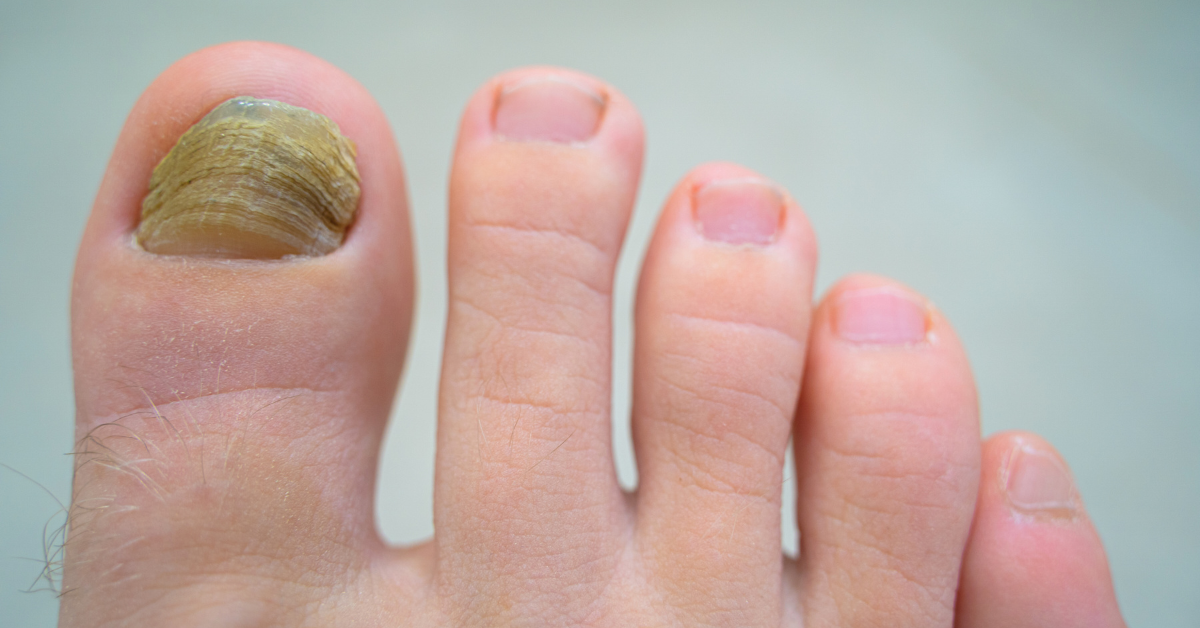9 Potential Causes for Black Fungus on Toenail
Sometimes, nail fungus can turn black because of the type of fungus that’s causing the infection. See, there are different kinds of fungus, and some of them can make your nails look black instead of just changing their color to white or yellow-brown. It can be kind of uncomfortable and not look very nice. But don’t worry! There are things you can do to help take care of it and make your nails healthier again.

Symptoms of Nail Fungus
- Thickened, discolored nails
- Brittle, crumbly, or ragged texture
- Misshapen or separated from the nail bed
- Unpleasant odor emanating from the affected nail
- More common in toenails than fingernails
Self-Care and Treatment
Here are some simple things you can do at home to take care of your nails if you think you have nail fungus:
Keep Your Nails Clean and Dry:
- Wash your feet and nails regularly with soap and water, and make sure to dry them well afterwards. Fungus likes warm, damp places, so keeping your nails clean and dry can help stop it from spreading.
Trim Your Nails Carefully:
- Use nail clippers to trim your nails straight across, and then file the edges gently to smooth them out. This can help prevent the fungus from getting worse and make your nails feel better.
Wear Breathable Shoes and Socks:
- Choose shoes and socks made from breathable materials like cotton or wool, and try to avoid wearing tight-fitting shoes for long periods of time. This can help keep your feet cool and dry, which is less inviting for fungus.
Apply Antifungal Cream:
- You can buy antifungal cream at the store and apply it to your nails as directed on the packaging. This can help kill the fungus and make your nails healthier.
Give Your Feet Some Air:
- Whenever you can, try to go barefoot or wear open-toed shoes to let your feet breathe. Fungus doesn’t like fresh air, so giving your feet some air can help fight off the infection.
Remember, it’s important to be patient and consistent with these treatments. It might take some time for your nails to get better, but if you keep taking care of them, they’ll start to look and feel healthier again!
When to Seek Medical Attention
Increasingly discolored, thickened, or misshapen nails despite self-care efforts
Presence of underlying health conditions such as diabetes, necessitating prompt evaluation and management
Additional symptoms like bleeding around the nails, swelling, pain, or difficulty walking warrant medical attention.
9 Potential Causes and Risk Factors
1. Fungal Infections
- Black fungus on toenails can be caused by fungal infections, such as dermatophytes, yeast, bacteria, or molds, with certain types potentially leading to discoloration.
2. Dermatophytes
- These are a type of fungus commonly responsible for nail infections, including those that may cause black discoloration on toenails.
3. Trauma or Injury
- Physical trauma or injury to the toenail can disrupt its structure and integrity, potentially leading to fungal infections and subsequent black discoloration.
4. Poor Nail Hygiene
- Inadequate nail hygiene practices, such as failing to keep nails clean and dry or using unsterilized nail tools, can create an environment conducive to fungal growth and black fungus development.
5. Moist Environments
- Prolonged exposure to damp or moist environments, such as sweaty socks or shoes, swimming pools, or communal shower areas, can promote fungal growth and contribute to black fungus on toenails.
6. Weakened Immune System
- Individuals with weakened immune systems, such as those with diabetes, HIV/AIDS, or undergoing immunosuppressive therapy, may be more susceptible to fungal infections, including black fungus on toenails.
7. Older Age
- Aging can lead to changes in nail structure and decreased immune function, making older adults more prone to fungal infections and black fungus development on toenails.
8. Underlying Health Conditions
- Certain underlying health conditions, such as peripheral vascular disease or psoriasis, can compromise nail health and increase the risk of fungal infections and subsequent black discoloration.
9. Genetic Predisposition
- Some individuals may have a genetic predisposition to fungal infections or abnormalities in nail structure, making them more susceptible to black fungus on toenails even without obvious external factors.
Prevention Strategies
Here are potential solutions and at-home treatments for each cause of black fungus on toenails:
Fungal Infections:
- Over-the-counter antifungal creams or ointments containing ingredients like clotrimazole, terbinafine, or miconazole.
- Prescription oral antifungal medications for severe or persistent infections.
Dermatophytes:
- Topical or oral antifungal medications prescribed by a healthcare professional.
- Proper nail hygiene practices, including keeping nails clean, dry, and trimmed.
Trauma or Injury:
- Gentle cleaning and protection of the injured toenail to prevent further damage and infection.
- Avoidance of tight-fitting or uncomfortable footwear that may exacerbate the injury.
Poor Nail Hygiene:
- Regular washing and drying of feet and toenails to maintain cleanliness.
- Proper nail trimming techniques, cutting nails straight across and avoiding cutting too close to the skin.
Moist Environments:
- Use of moisture-wicking socks and breathable footwear to keep feet dry.
- Application of antifungal foot powders or sprays to reduce moisture and inhibit fungal growth.
Weakened Immune System:
- Proper management of underlying health conditions in consultation with a healthcare professional.
- Regular monitoring and maintenance of foot health to prevent fungal infections.
Older Age:
- Increased attention to foot hygiene and regular inspection of toenails for signs of fungal infection.
- Use of antifungal treatments as needed, in consultation with a healthcare professional.
Underlying Health Conditions:
- Comprehensive management of underlying health conditions to improve overall health and immune function.
- Collaboration with a healthcare provider to address specific concerns related to nail health and fungal infections.
Genetic Predisposition:
- Adherence to proper nail hygiene practices and regular foot care routines.
- Prompt treatment of any fungal infections or abnormalities in toenail appearance to prevent worsening or recurrence.
Conclusion
Empower yourself with knowledge and proactive measures to combat nail fungus effectively. By understanding the symptoms, seeking timely medical attention, and implementing preventive strategies, you can take control of your nail health and step confidently towards healthier, fungus-free nails.

Leave a Reply